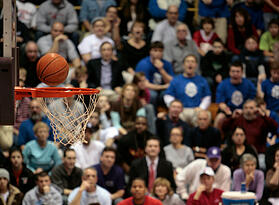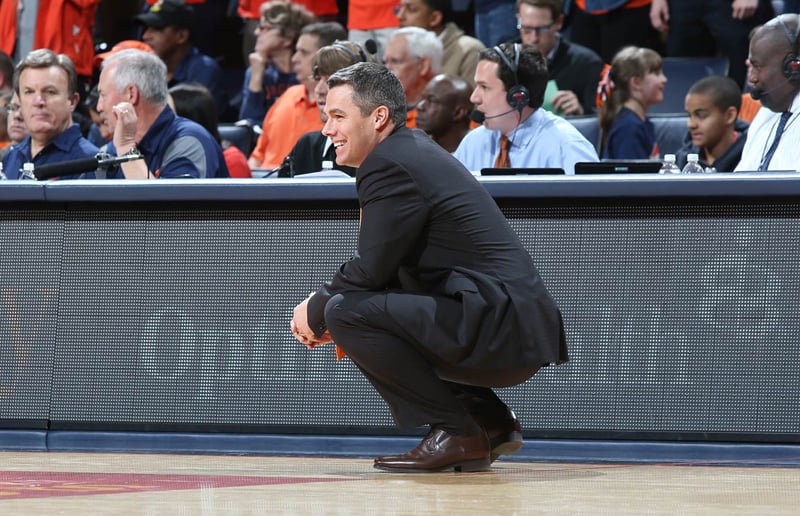New NCAA Men's Basketball Rules Increase Shooting Opportunities
Before the c urrent men’s college basketball season, the NCAA tweaked its rules to allow for more offensive freedom in hopes of increased scoring after Division I teams averaged 67.5 points per game in 2012-13. That figure was the lowest scoring average since 1981-82 when teams averaged 67.6 points per game. Scoring had been on a decline for the past four seasons at the Division I level.
urrent men’s college basketball season, the NCAA tweaked its rules to allow for more offensive freedom in hopes of increased scoring after Division I teams averaged 67.5 points per game in 2012-13. That figure was the lowest scoring average since 1981-82 when teams averaged 67.6 points per game. Scoring had been on a decline for the past four seasons at the Division I level.
Some media and fans called the game unwatchable with its constant hand-checking and body jamming.
With these statistics and the state of the game in mind, the NCAA stressed to its officials to consistently call fouls this season if a player:
- Keeps a hand or forearm on an opponent
- Puts two hands on an opponent
- Continually jabs by extending his arm(s) and placing a hand or forearm on an opponent
- Uses an arm bar to impede the progress of an opponent
Simply put—if you put a hand on the offensive player, you will be called for a foul. The new rules were intended to change the game back to one of skill rather than muscle.
Initially, games may have been slightly over-officiated when referees were adamant about enforcing the new rules. But it seems with a month to go in the season, everyone has adjusted for the better. Fouls called per team have dropped from 20.2 in November to 18.8 in the first half of February.
NCAA teams are now averaging 71.68 points per game. If teams maintain that pace, it will be the highest scoring season since 1995-96.
Dan Gavitt, vice president of NCAA men’s basketball championships, told the Fort Worth Star-Telegram that he considers the new rules significant steps in the right direction. National field-goal percentage has also increased by 1 percent and turnovers have decreased by nearly 10 percent from last year.
“You’re not talking about drastic change. But you are talking about improvement in the right trend, rather than the wrong trend, which has been the case over the last 20 years,” Gavitt said in the Star-Telegram. “We got to a point last year where we had the lowest points per game and the lowest number of fouls called (17.68 per team compared to 19.3 per team this year) in the 65 years that the NCAA has kept statistics.”
Focus on the action at the top of the key in any men’s college basketball game, and you’ll notice the remarkable change. No longer are ballhandlers knocked off their path or jammed by a swarm of hands and arms. There is space now and freedom of movement.
Highly skilled offensive players are taking advantage of defensive isolations whether they are penetrating the lane to create contact or kicking out for an open three-pointer. Fouls shots per team are up to 22.5 per game this season compared to 19.8 in 2012-13. Field-goal percentage and three-pointer percentage have also increased.

University of Virginia coach, Tony Bennett, the first NCAA Division I coach to officially endorse the Noah System, has his Cavaliers ranked No. 5 in the country. After 30 games, UVA has attempted 645 free throws compared to 565 in 35 games last season. That boost has helped the Cavaliers up their scoring from 64.2 points per game to 66.2 points per game.
It appears the new rule enforcements have affected the women’s college game as well. A recent story by the Lafayette Journal and Courier points to increased scoring in the women’s Big Ten Conference.
Heading into the Big Ten Tournament in Indianapolis, half the teams averaged more than 70 points this season compared to one last year. The league is collectively averaging 71.1 points.
Many in the conference have attributed the lift in scoring to more opportunities at the foul line. According to the Journal and Courier, 10 of the 12 teams shot 71.3 percent or better and six — Nebraska, Purdue, Penn State, Minnesota, Michigan and Wisconsin — rank in the top 45 nationally in free throw percentage.